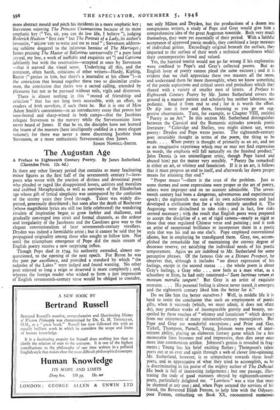James and Stevenson - Henry James and Robert Louis Stevenson. A
Record of Friendship and Criticism. Edited with an introduction by Janet Adam Smith. (Hart-Davis. 12s. 6d.) Tin unwitting agent of providence was that essentially minor Victorian novelist Walter Besant. If Besant had not pontificated; at the Royal Institution in 1884, on the proper limitations and conscious moral purpose of the novel, James would not have contributed to Longman's Magazine his Art of Fiction, an affirmation of the dignity and a plea for the liberty of this " most magnificent form of art nor would Stevenson have replied, also in Longman's, with A Humble Remonstrance, an eloquent elaboration of the theme that the story-teller's metier is to tell a story. It was this exchange of manifestos that led James to write to Stevenson as gratifying a letter as ever author received from a stranger ; to which Stevenson replied in kind. They met in the summer of 1885 ; two years later Stevenson left England for the last time, and in little more than another seven years he was dead.
The friendship began quickly and went deep. It was satisfying and stimulating to both. If satisfied in each the need for the stimulus of appreciation by an artist of like mind and like calibre. James in London was still something of a fish out of water ; he enjoyed reclame but no sales, and his literary friends were mostly either lightweights or sycophants. As for Stevenson, marriage had upset the balance of his friendships—notably his emotional but artistically fertile relationship with Henley—and his decision to leave Europe aroused, not sympathy but uncomprehending resentment in the Colvins, Gosses and Andrew Langs. James, not having known Stevenson as a bachelor, was willing—and able—to engage the affec- tion of that " poor barbarous and merely instinctive, lady," Fanny Stevenson ; moreover he was almost alone in making the effort of imagination necessary to accept the Samoan exile. The measure of Stevenson's affection and trust for James is his naming him an executor. What James thought of Stevenson he wrote, when the news of his friend's death reached him, to Gosse:
" It makes me cold and sick—and with the nbsolute, almost alarmed, sense of the visible material quenching of an indispensable light . . . . I'm not sure that it's not for him a great and happy fate ; but for us the loss of charm, of suspense, of ' fun ' is unutterable."
Miss Adam Smith has had the brilliant thought of assembling the two Longman's essays, all the known letters that passed between the friends (a few of them unpublished before), Stevenson's verses to James and James's two published appreciations of Stevenson: The letters of one man, in bulk, however good, are slow reading ; to print both sides of a correspondence in a single volume is more than to double the pace, and the pace of this volume is exhilarating. Here we have the great Anglo-American exponent of the new French analytical-psychological novel publicly preferring Treasure Island to Goncourt's Cherie on the ground that the one "succeeded wonderfully " in what it attempted while the other did not ; here we have Stevenson publicly proving by his analysis of The Author of Beitraffio that, writer of boys' adventure stories though he might be, he was yet competent to judge what a " novel of character " attempted, how it attempted it, and how far it succeeded ; Stevenson privately, in his first Jetter, recognising himself, as a'craftsman, to be " a lout and slouc7h of the first water " compared with James, yet in the same breath imploring James to cast- his characters in a more abstract mould and-pitch his incidents in a more emphatic key.; Stevenson enjoying The Princess Casamassima because of its more emphatic key (" Yes, sir, you can do low life, I believe "), judging Roderick Hudson " first rate " but The Portrait of a Lady, its author's favourite, "BELOW YOU to write and me to read " ; Stevenson address- ing sublime doggerel to the infamous heroine of The Marriages ; James praising The Master of Ballantrae unreservedly (" a pure hard :rystal, my boy, a work of ineffable and exquisite art ") and Catriona jubilantly but with the reservation—accepted at once by Stevenson —that it starved the visual sense. Underlying all this, and the pertinent, often harsh, criticisms of other writers—Hardy, Kipling, Barrie (" genius in him, but there's a journalist at his elbow ")—is the conviction that bound together these two so dissimilar crafts- men, the conviction that theirs was a sacred calling, attended by pleasures but not to be pursued without toils, vigils and distresses. There is almost nothing in this " record of friendship and criticism " that has not long been accessible, with, an effort, to readers of both novelists, if such there be. But it is one of Miss Adam Smith's contentions—in an introductory essay that proves her sure-footed and sharp-witted in both camps—that the Jacobites relegate Stevenson to the nursery while the Stevensonians have never heard of James. If that be so, the disciples have not learned the lesson of the masters (here intelligently codified in a most elegant volume); for there was never a more discerning Jacobite than Stevenson, or a more enthusiastic Stevensonian than James.
SIMON NOWELL-SMITH.











































 Previous page
Previous page